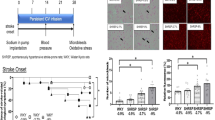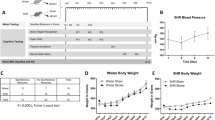Summary
In an attempt to clarify the role of lysosomal enzymes in the developmental mechanisms of cerebral lesions under chronic hypertensive conditions, we biochemically investigated the activities of acid phosphatase (AcPase), N-àcetyl β-glucosaminidase (NAGase) and cathepsin B (CathB) in the cerebral cortex and subcortical white matter in stroke-prone spontaneously hypertensive rats (SHRSPs). We also investigated enzyme-histochemically the activities of AcPase and NAGase, and immunohistochemically the distribution of CathB. The activities of all enzymes tended to increase with advancing age. The enzyme activities in the aged SHRSPs were in general higher than those in normotensive rats, the differences being significant at 24 weeks of age. Histochemical investigation showed that SHRSPs had an increased number of cells with positive reaction to these enzymes in the edematous cortex with and without vascular changes, and degenerated subcortical white matter. These cells with positive reaction were made up of reactively increased astrocytes and microglia. Neurons in the edematous area also showed slightly intensified enzyme activities. The present studies suggest that chronic hypertension or chronic edema due to hypertension causes increased activities of lysosomal enzymes in the cerebral cortex and subcortical white matter and, thus, that activated lysosomal enzymes may take part in the developmental mechanisms of cystic formation as well as the diffuse degeneration of the white matter.
Similar content being viewed by others
References
Barka T, Anderson PJ (1962) Histochemical methods for acid phosphatase using hexazonium pararosanilin as coupler. J Histochem Cytochem 10: 741–753
Bernstein H-G, Kirschke H, Wiederanders B, Schmidt D, Rinne A (1990) Antigen expression of cathepsin B in aged human brain. Brain Res Bull 24: 543–549
Bradley JD, Whitaker JN (1986) Isolation and characterization of cathepsin B from bovine brain. Neurochem Res 11: 851–867
Brunck CF, Jones KC, James TW (1979) Assay for nanogram quantities of DNA in cellular homogenates. Anal Biochem 92: 497–500
Cataldo A, Paskevich PA, Kominami E, Nixon RA (1991) Lysosomal hydrolases of different classes are abnormally distributed in brains of patients with Alzheimer disease. Proc Natl Acad Sci USA 88: 10998–11002
Dannenberg AN, Wabier PC, Kapral FA (1963) A histochemical study of phagocytic and enzymatic functions of rabbit mononuclear and polymorphonuclear exudate cells and alveolar macrophages. J Immunol 90: 448–465
DeDuve C (1959) Lysosomes a new group of cytoplasmic particle. In: Hayashi T (ed) Subcellular particles. Ronald Press, New York, pp 128–159
Fredriksson K, Auer PN, Kalimo H, Nordborg C, Olsson Y, Johansson BB (1985) Cerebrovascular lesions in stroke-prone spontaneously hypertensive rats. Acta Neuropathol 68: 284–294
Fredriksson K, Kalimo H, Nordborg C, Johansson BB, Olsson Y (1988) Nerve cell injury in the brain of stroke-prone spontaneously hypertensive rats. Acta Neuropathol 76: 227–237
Fredriksson K, Kalimo H, Nordborg C, Olsson Y, Johansson BB (1988) Cyst formation and glial response in the brain lesions of spontaneously hypertensive rats. Acta Neuropathol 76: 441–450
Hanakita J, Hazama F, Amano S, Yamada E, Handa H (1980) Histochemical study on oxidative enzyme activity in the brain, particularly of astrocytes, in spontaneously hypertensive rats. Neuropathol Appl Neurobiol 6: 471–482
Hayashi M (1965) Histochemical demonstration of N-acetyl β-glucosaminidase employing naphthol AS-BI N-acetyl β-glucosaminide as substrate. J Histochem Cytochem 13: 355–360
Hazama F, Amano S, Haebara H, Okamoto K (1975) Changes in vascular permeability in the brain of stroke-prone spontaneously hypertensive rats studied with peroxidase as a tracer. Acta Pathol Jpn 25: 565–574
Hazama F, Haebara H, Amano S, Okamoto K (1975) Pathology of cerebrovascular diseases in spontaneously hypertensive rats. 7th Int Congr Neuropathol. Excerpta Medica, Amsterdam, pp 517–520
Hazama F, Ooshima A, Tanaka T, Tomomoto K, Okamoto K (1975) Vascular lesions in the various substrains of spontaneously hypertensive rats and effects of chronic salt ingestion. Jpn Circ J 39: 7–22
Hazama F, Amano S, Haebara H, Yamori Y, Okamoto K (1976) Pathology and pathogenesis of cerebrovascular lesions in spontaneously hypertensive rats. In: Cervos-Navarro J, Betz E, Matakas F, Wuellenweber R (eds) The cerebral vessel wall. Raven Press, New York, pp 245–252
Kominami E, Tsukahara T, Bando Y, Katumuna N (1985) Distribution of cathepsin B and H in rat tissues and peripheral blood cells. J Biochem 99: 87–93
Leaback DH, Walker PG (1961) Studies of glucosiaminidase. IV. The fluorimetric assay of N-acetyl-β-glucosaminidase. Biochem J 78: 151–156
Mannoji H, Yeger H, Becker LE (1986) A specific histochemical marker (lectin Ricinus communis agglutinin-1) for normal human microglia, and application to routine histopathology. Acta Neuropathol 71: 341–343
Nakamura Y, Takeda M, Suzuki H, Hattori H, Tada K, Hariguchi S, Hashimoto S, Nishimura T (1991) Abnormal distribution of cathepsins in the brain of patients with Alzheimer's disease. Neurosci Lett 130: 195–198
Ogata J, Fujishima M, Tamaki K, Nakatomi Y, Ishitsuka T, Omae T (1980) Stroke-prone spontaneously hypertensive rats as an experimental model of malignant hypertension. I. A light-and electron microscopic study of the brain. Acta Neuropathol (Berl) 51: 179–184
Peters TJ, deDuve C (1974) Lysosomes of the arterial wall. II. Subcellular fractionation of aortic cells isolated from rabbits with experimental atheroma. Exp Mol Pathol 20: 228–256
Seymour C, Peters TJ (1977) Enzyme activities in human liver biopsies: assay methods and activities of some lysosomal and membrane-bound enzymes in control tissue and serum. Clin Sci Mol Med 52: 229–239
Stanton DA, Cohn ZA (1970) In vitro induction of lysosomal enzymes of phagocytosis. J Exp Med 131: 1239–1260
Stoward PJ, Spicer SS, Miller RL (1980) Histochemical reactivity of penut lectin-horseradish peroxidase conjugate. J Histochem Cytochem 28: 979–990
Watanabe M, Yamada E, Hazama F, Nomura T (1981) Acid phosphatase activity in the aorta of spontaneously hypertensive rats and the effect of various antihypertensive drugs. Atherosclerosis 40: 167–174
Yamada E, Hazama F, Amano S, Hanakita J (1979) Acid phosphatase activity of the brain in SHR. Jpn Circ J 39: 285–292
Yamada E, Hazama F, Amano S, Hanakita J (1980) Cytochemical investigation on acid phosphatase activity in cerebral arteries in spontaneously hypertensive rats. Jpn Circ J 44: 467–475
Yanagisawa K, Sato S, Miyatake T, Kominami E, Katsunuma N (1984) Degradation of myelin proteins by cathepsin B and inhibition by E-64 analogue. Neurochem Res 9: 691–694
Yukioka N, Yamada E, Sasahara M, Kawai J, Hayase Y, Amano S, Hazama F (1988) Lysosomal enzyme activities in the cerebral microvessels in spontaneously and renal hypertensive rats. Exp Mol Pathol 49: 111–117
Author information
Authors and Affiliations
Additional information
Supported in part by a Grant-in-Aid for Scientific Research from the Ministry of Education, Science and Culture of Japan
Rights and permissions
About this article
Cite this article
Chue, CH., Yukioka, N., Yamada, E. et al. The possible role of lysosomal enzymes in the pathogenesis of hypertensive cerebral lesions in spontaneously hypertensive rats. Acta Neuropathol 85, 383–389 (1993). https://doi.org/10.1007/BF00334448
Received:
Revised:
Accepted:
Issue Date:
DOI: https://doi.org/10.1007/BF00334448




